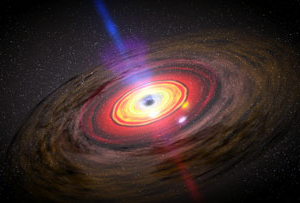Cosmic research picked in breakthroughs of 2011
Astronomers from the Dark Cosmology Centre (DARK) at the Niels Bohr Institute have developed a groundbreaking method for measuring long distances in the universe using light from quasars. Quasars are active black holes and their light surpasses all other sources of light in the universe. This new groundbreaking method was published in Astrophysical Journal Letters in September, and now Physics World, the magazine of the UK's physical society has chosen this research as one of the most important breakthroughs in physics in 2011.
 Astrophysicist Darach Watson, Dark Cosmology Centre at Niels Bohr Institute
Astrophysicist Darach Watson, Dark Cosmology Centre at Niels Bohr Institute“It means a lot to me that the work has been recognized and it is an honour that it was selected among all sorts of research worldwide”, says astrophysicist Darach Watson, Dark Cosmology Centre at Niels Bohr Institute at the University of Copenhagen.
To measure great distances, astronomers need powerful light sources, which light up like cosmic lighthouses and can be observed across the universe. Darach Watson got the idea to use quasars to measure distances in the universe during a lecture, where one of his colleagues was talking about quasars. Quasars are active black holes at the centre of early galaxies. Because of the enormous gravitational pull, matter is dragged from the surroundings in towards the black hole and as the material swirls together, it is heated to millions of degrees. This extremely hot matter emits X-ray and ultraviolet radiation, which then irradiates the huge dense clouds of gas that circulate at a distance from the black hole.
The heated material lights up with a radiation that is stronger than the light from 1000 galaxies. But in order to use quasars to measure distances in the universe, you need to know the exact brightness of the light source, and up until now it has not been possible to calculate this.

Every galaxy has a supermassive black hole at its heart, millions to billions of times the mass of the Sun. When these dark hearts of galaxies actively accrete matter they become incredibly bright. These are quasars, and they outshine everything else in the universe.
“I got the idea that if the brightness of the quasar was linked to the size of the gas cloud around it and if you could measure the size of this cloud, then you would be able to calculate the distance to the quasar”, explains Darach Watson, who worked with colleagues at DARK, Kelly Denney and Marianne Vestergaard, and Tamara Davis from the University of Queensland, to publish the work.
The key to the calculations is that the size of the irradiated clouds depends on the luminosity of the quasar - the brighter the quasars the greater the irradiated cloud around it. There was already a method to measure the size of the gas cloud, so they could now calculate the luminosity of the quasar. The result is that quasars are a good source for measurements far back into the very early universe – as far as 85 % of the universe’s age back in time, and the measurements have proven to be very accurate.
It is this breakthrough that has now received this international recognition from Physics World, which especially points out that the research has fundamental importance, represents significant progress in knowledge, has a strong connection between theory and practical experiments and is of general interest for all physicists. “We are particularly impressed with how you and your colleagues have expanded astronomers’ ability to look back in time using quasars, which are ubiquitous in the universe”, reads the citation from Physics World.
